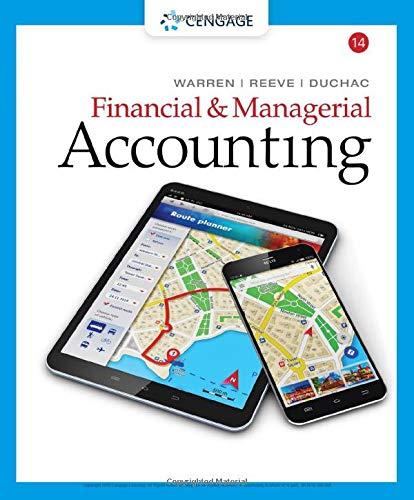Question
Problem 14-1A Cost computation, classification, and analysis C2 C3 Listed here are the total costs associated with the production of 1,000 drum sets manufactured by
Problem 14-1A Cost computation, classification, and analysis C2 C3
Listed here are the total costs associated with the production of 1,000 drum sets manufactured by TrueBeat. The drum sets sell for $500 each.
| Variable or Fixed | Product or Period | |||
| Costs | Variable | Fixed | Product | Period |
| 1. Plastic for casing$17,000 | $17,000 | ____ | $17,000 | ____ |
| 2. Wages of assembly workers$82,000 | ____ | ____ | ____ | ____ |
| 3. Property taxes on factory$5,000 | ____ | ____ | ____ | ____ |
| 4. Accounting staff salaries$35,000 | ____ | ____ | ____ | ____ |
| 5. Drum stands (1,000 stands purchased)$26,000 | ____ | ____ | ____ | ____ |
| 6. Rent cost of equipment for sales staff$10,000 | ____ | ____ | ____ | ____ |
| 7. Upper management salaries$125,000 | ____ | ____ | ____ | ____ |
| 8. Annual flat fee for factory maintenance service$10,000 | ____ | ____ | ____ | ____ |
| 9. Sales commissions$15 per unit | ____ | ____ | ____ | ____ |
| 10. Machinery depreciation, straight-line$40,000 | ____ | ____ | ____ | ____ |
| Table Summary: In the table, a spanner heading appears over the column headings for columns 2 and 3 and for columns 4 and 5. In row 1, data are found in columns 2 and 4. All other cells in columns 2 through 5 contain blank lines. | ||||
Required
- Classify each cost and its amount as (a) either variable or fixed and (b) either product or period. (The first cost is completed as an example.)
Check (1) Total variable production cost, $125,000
- Compute the manufacturing cost per drum set.
Analysis Component
- Assume that 1,200 drum sets are produced in the next year. What do you predict will be the total cost of plastic for the casings and the per unit cost of the plastic for the casings?
- Assume that 1,200 drum sets are produced in the next year. What do you predict will be the total cost of property taxes and the per unit cost of the property taxes?
Problem 14-2A Classifying costs C2 C3
The following calendar year-end information is taken from the December 31, 2019, adjusted trial balance and other records of Leone Company.
| Advertising expense | $ 28,750 | Miscellaneous production costs | $ 8,425 |
| Depreciation expenseOffice equipment | 7,250 | Office salaries expense | 63,000 |
| Depreciation expenseSelling equipment | 8,600 | Raw materials purchases (direct materials) | 925,000 |
| Depreciation expenseFactory equipment | 33,550 | Rent expenseOffice space | 22,000 |
| Factory supervision | 102,600 | Rent expenseSelling space | 26,100 |
| Factory supplies used (indirect materials) | 7,350 | Rent expenseFactory building | 76,800 |
| Factory | 33,000 | Maintenance expenseFactory equipment | 35,400 |
| Direct labor | 675,480 | Sales | 4,462,500 |
| Indirect labor | 56,875 | Sales salaries expense | 392,560 |
Required
- Classify each cost as either a product or period cost.
- Classify each product cost as either direct materials, direct labor, or factory overhead.
- Classify each period cost as either selling expenses or general and administrative expenses.
Problem 14-3A Schedule of cost of goods manufactured and income statement; inventory analysis A1 P2
Using the data from Problem 14-2A and the following additional inventory information for Leone Company, complete the requirements below. Assume income tax expense is $233,725 for the year.
| Inventories | |
| Raw materials, December 31, 2018 | $166,850 |
| Raw materials, December 31, 2019 | 182,000 |
| Work in process, December 31, 2018 | 15,700 |
| Work in process, December 31, 2019 | 19,380 |
| Finished goods, December 31, 2018 | 167,350 |
| Finished goods, December 31, 2019 | 136,490 |
Required
- Prepare the companys 2019 schedule of cost of goods manufactured.
Check (1) Cost of goods manufactured, $1,935,650
- Prepare the companys 2019 income statement that reports separate categories for (a) selling expenses and (b) general and administrative expenses.
Analysis Component
- Compute the (a) inventory turnover, defined as cost of goods sold divided by average inventory, and (b) days sales in inventory, defined as 365 times ending inventory divided by cost of goods sold, for both its raw materials inventory and its finished goods inventory. (To compute turnover and days sales in inventory for raw materials, use raw materials used rather than cost of goods sold.) Round answers to one decimal place.
Step by Step Solution
There are 3 Steps involved in it
Step: 1

Get Instant Access with AI-Powered Solutions
See step-by-step solutions with expert insights and AI powered tools for academic success
Step: 2

Step: 3

Ace Your Homework with AI
Get the answers you need in no time with our AI-driven, step-by-step assistance
Get Started


